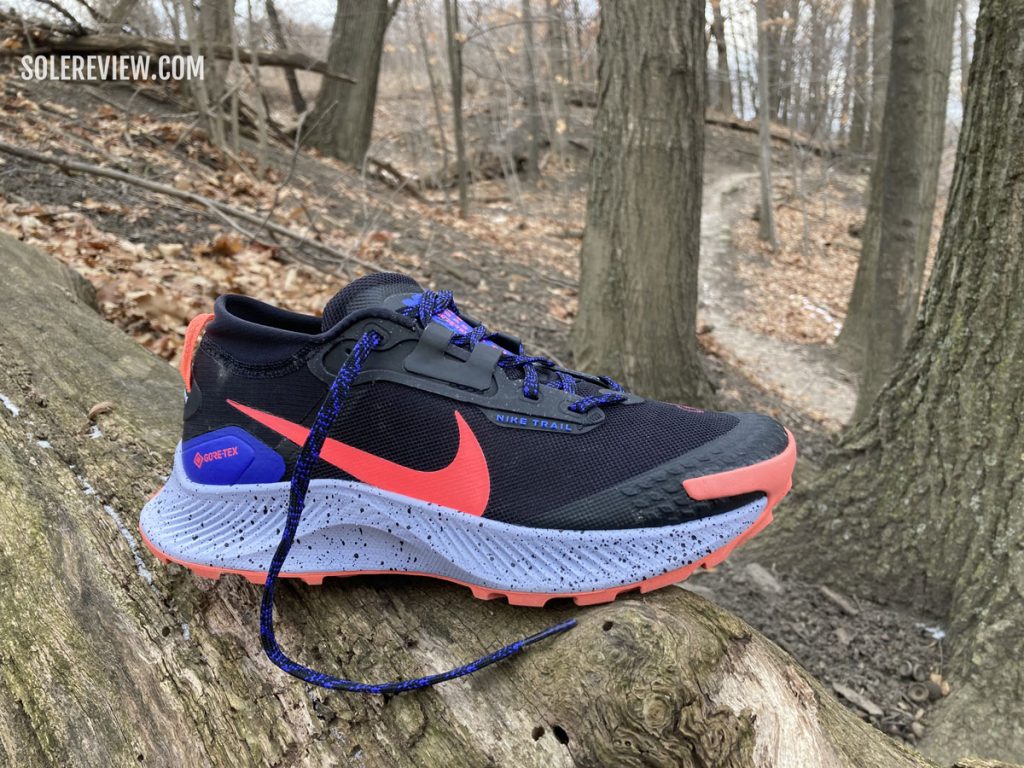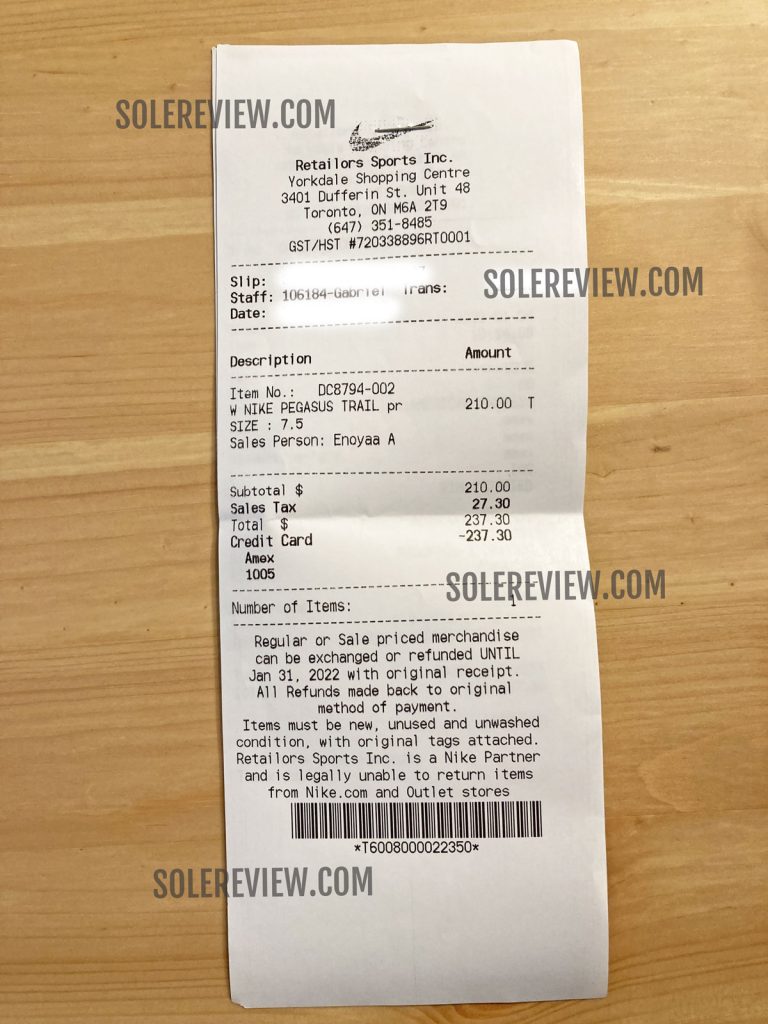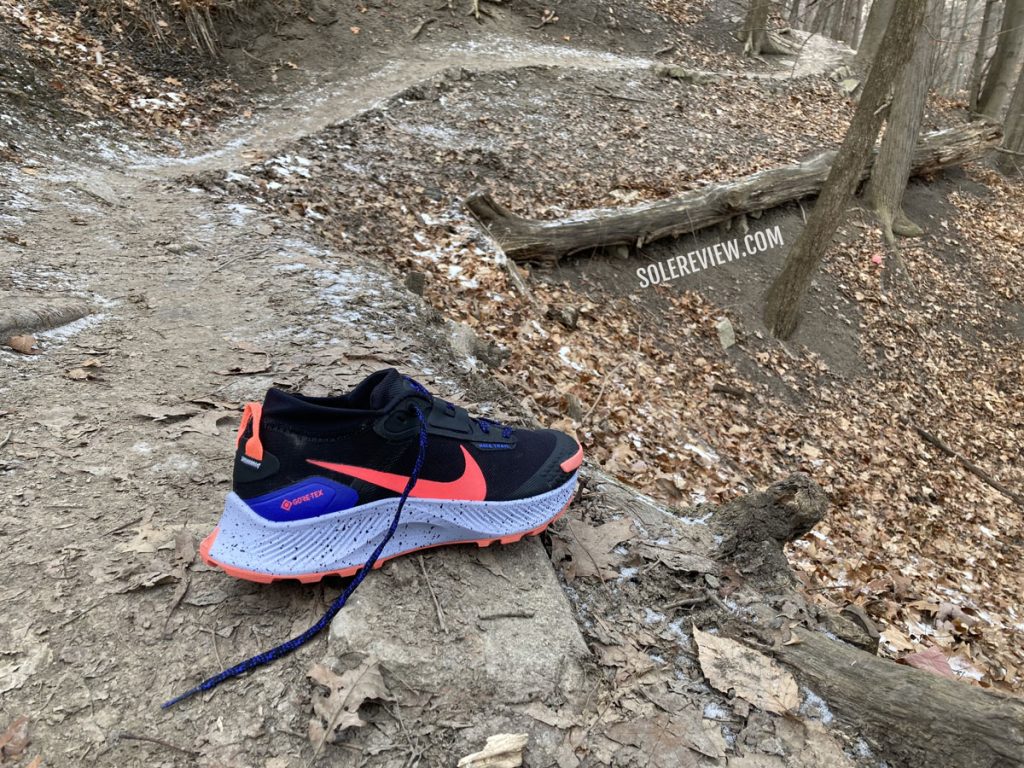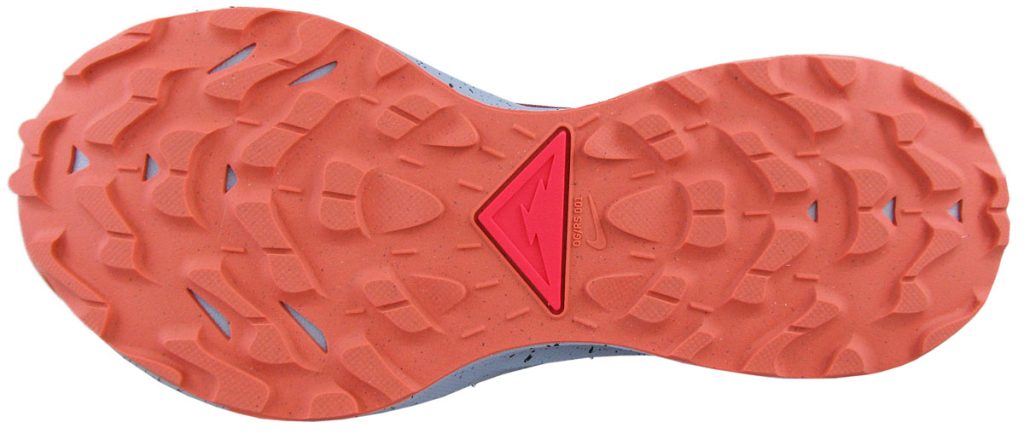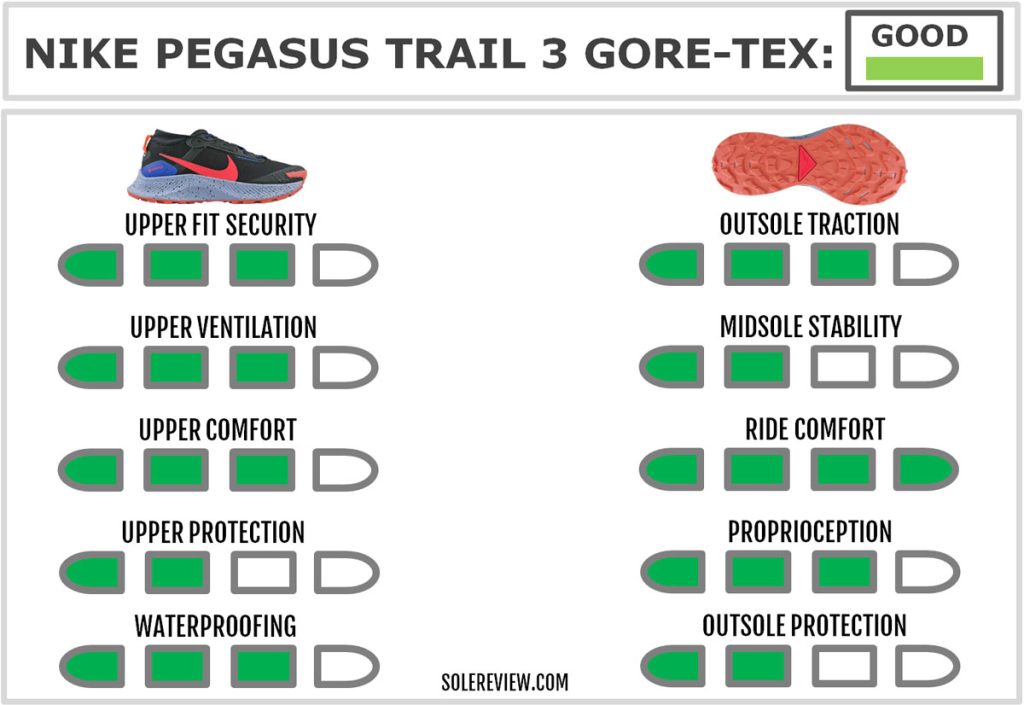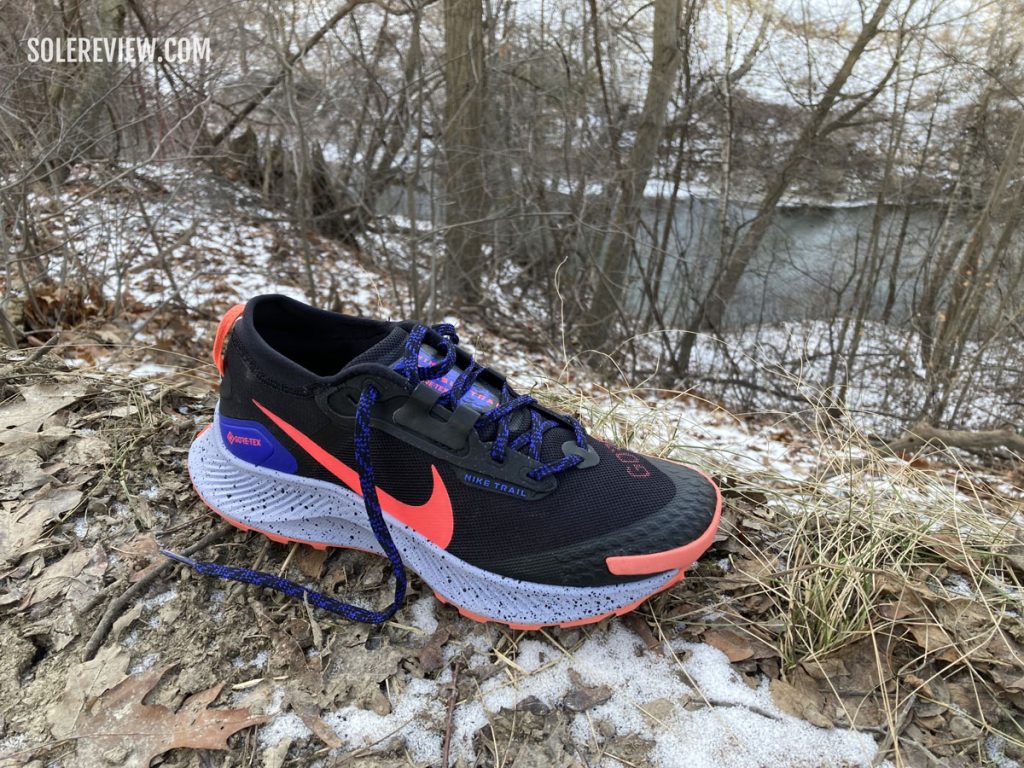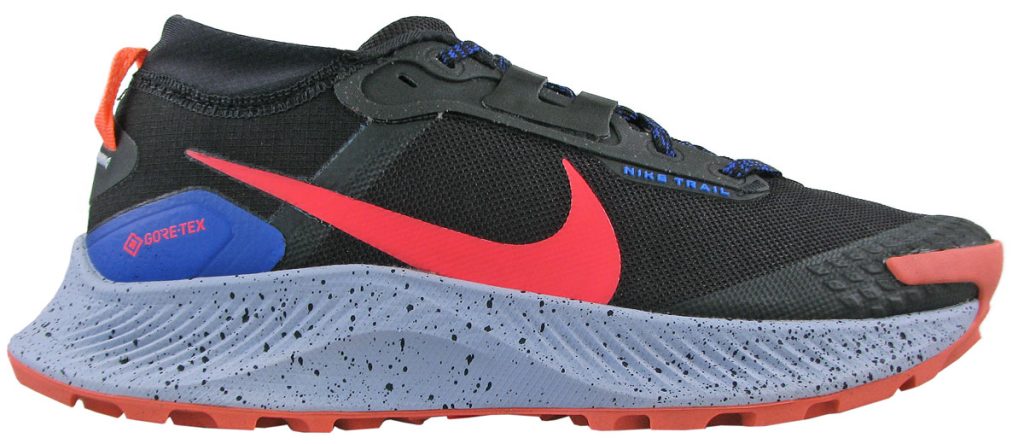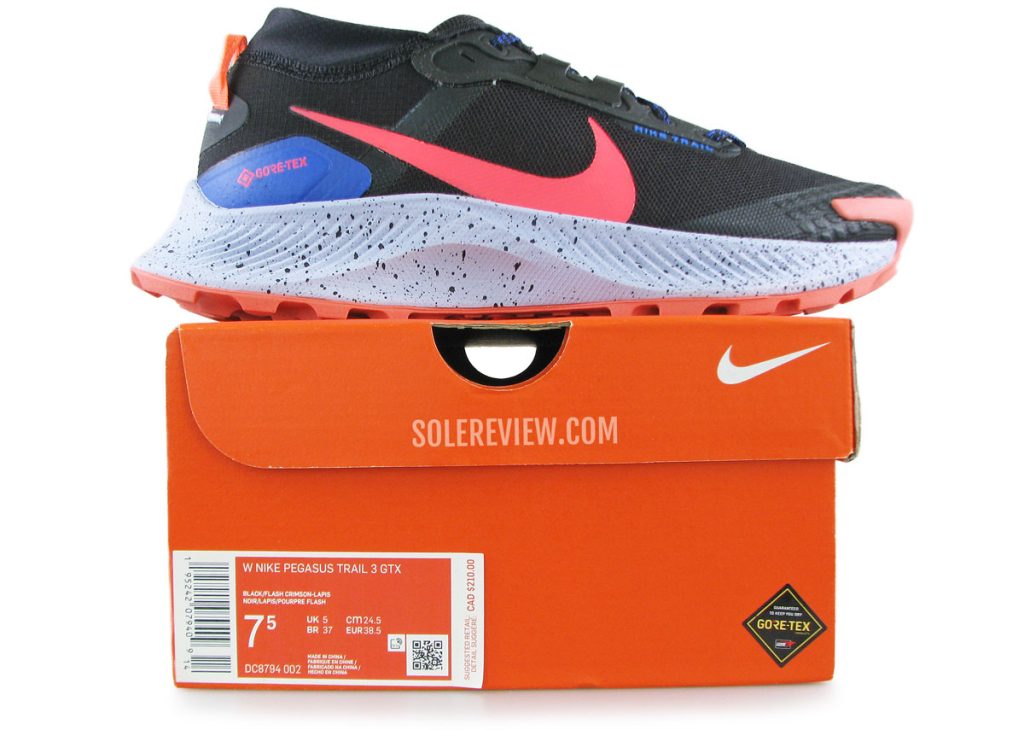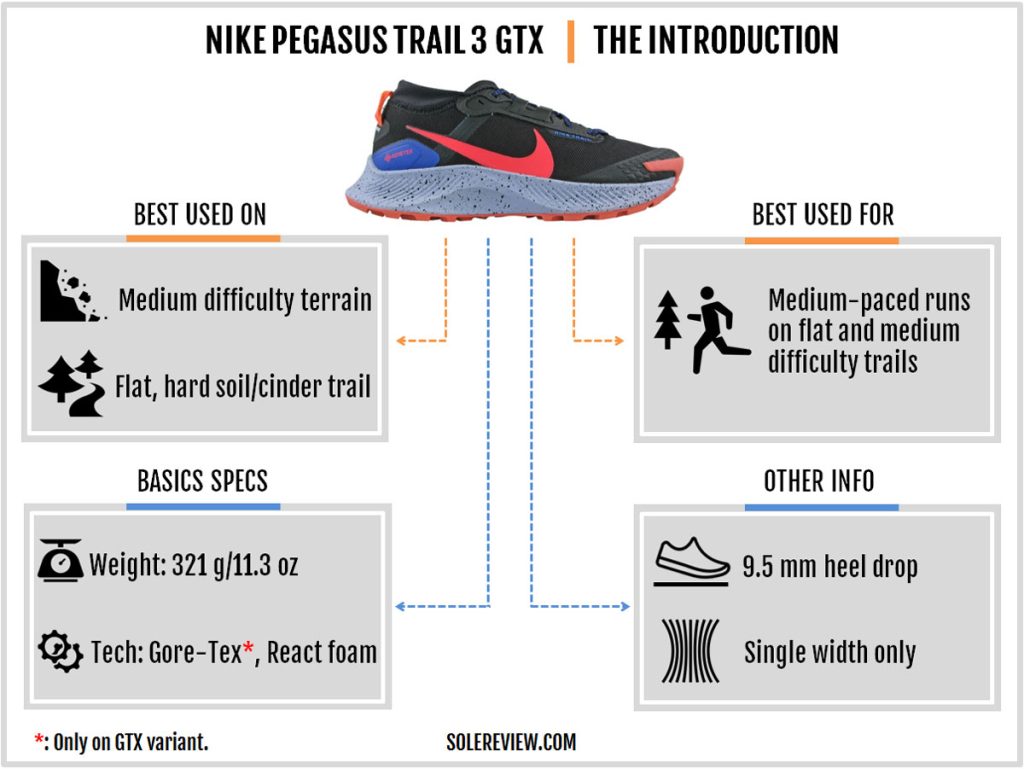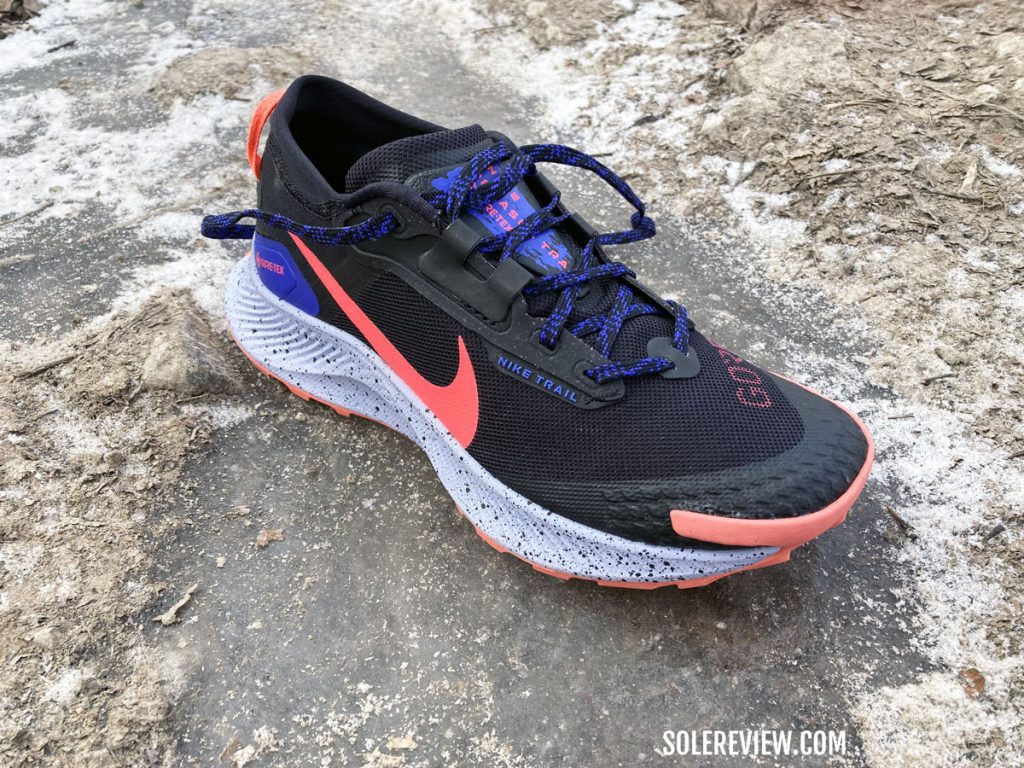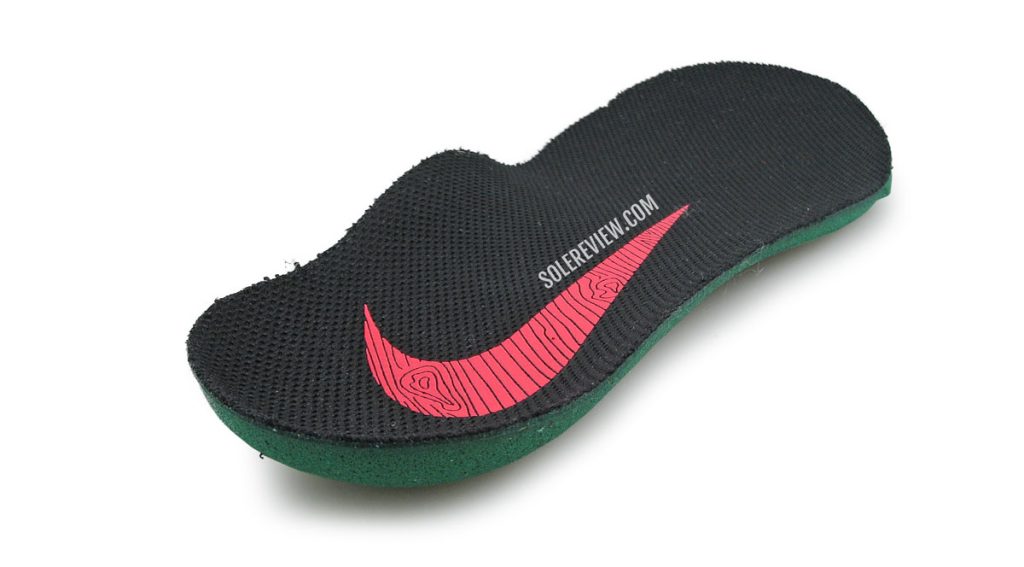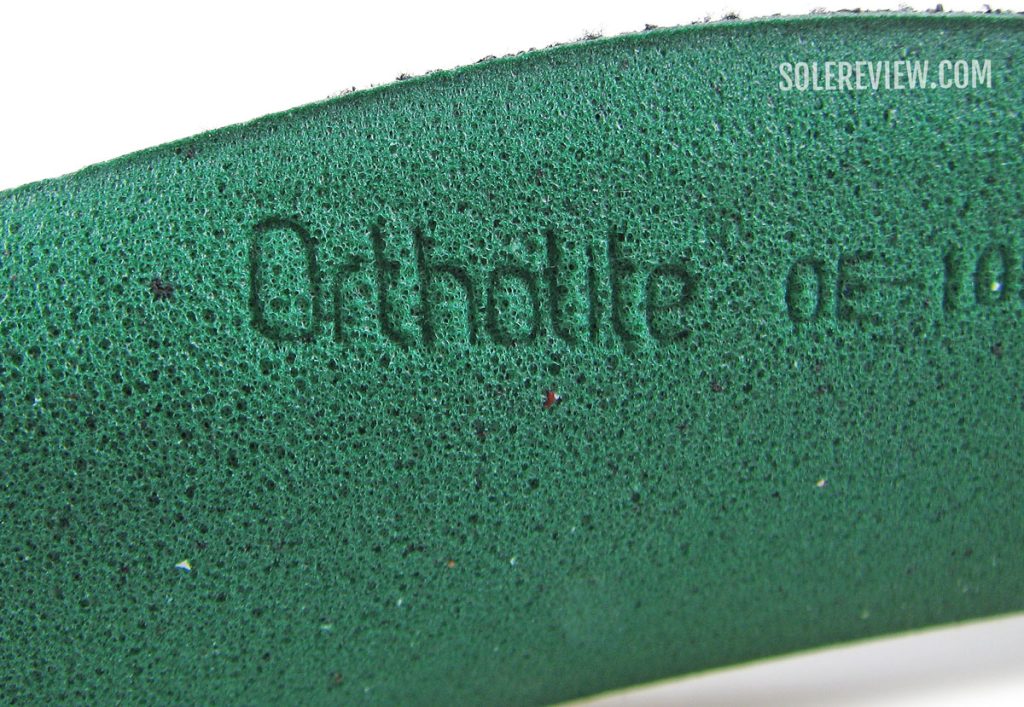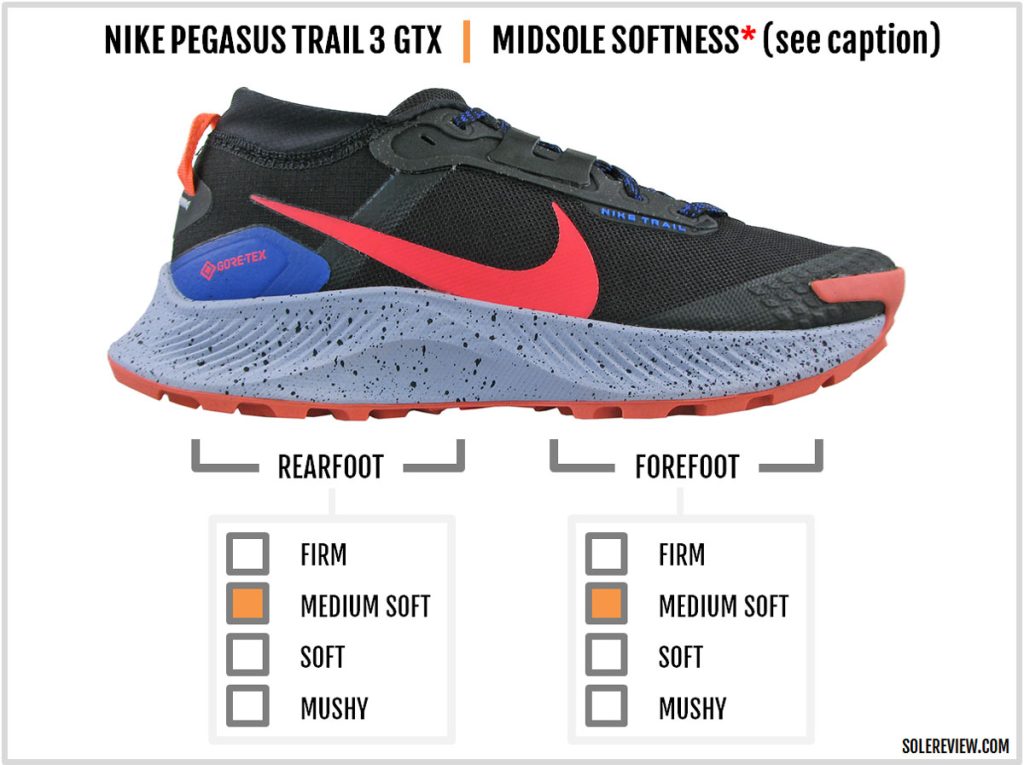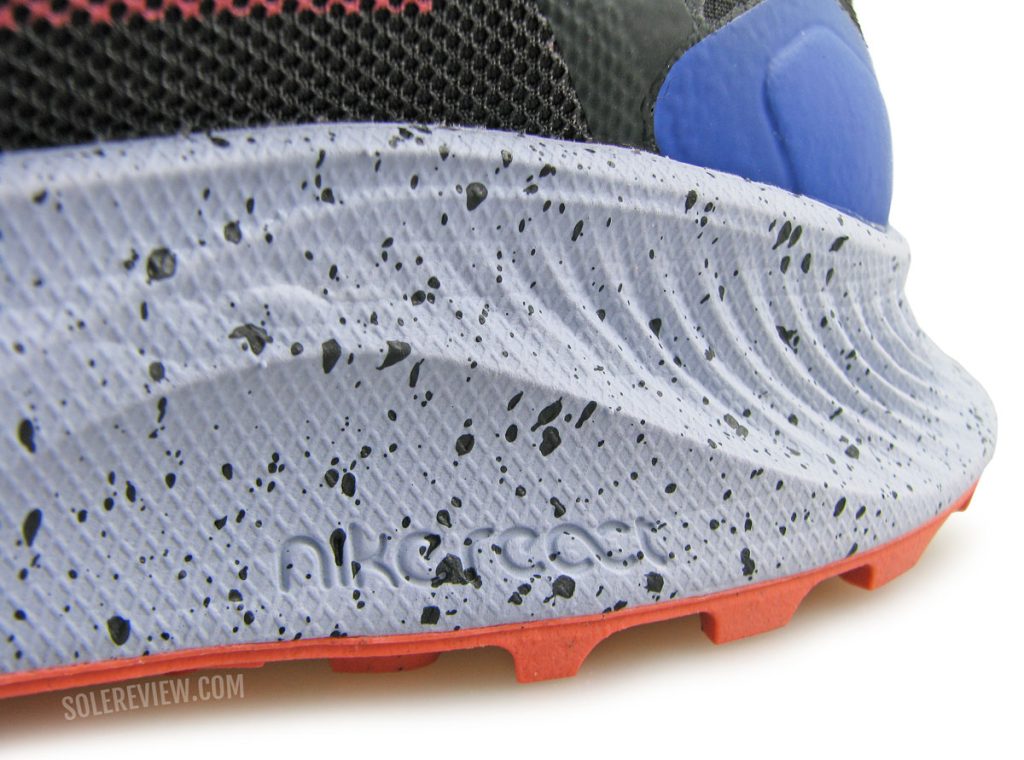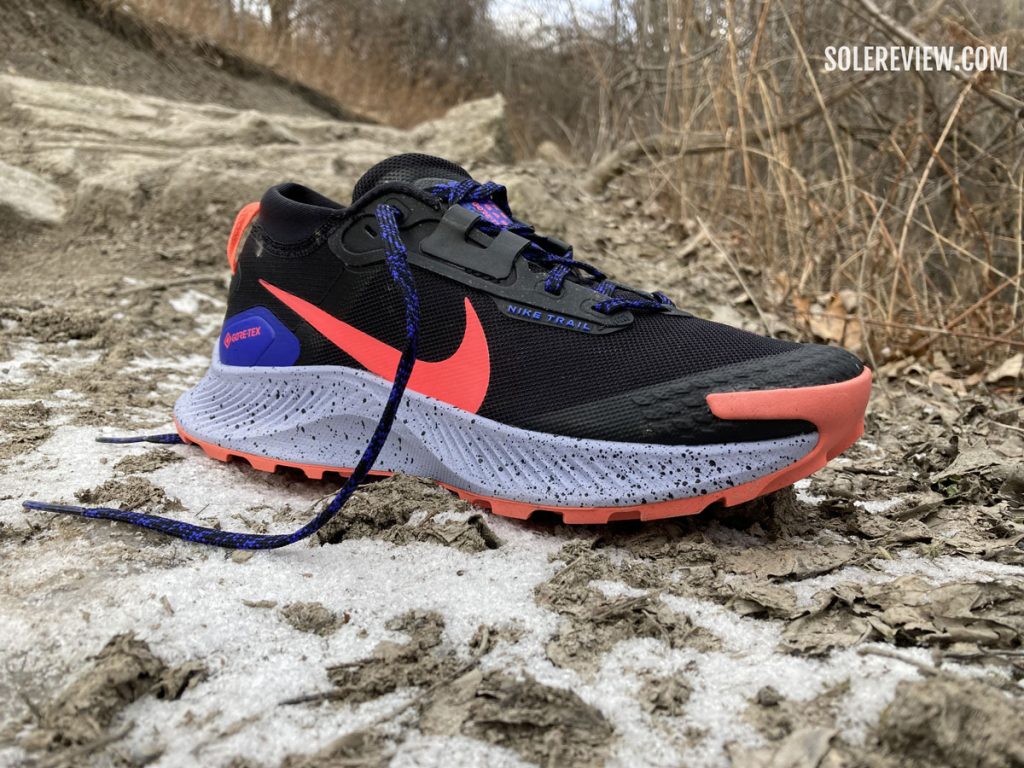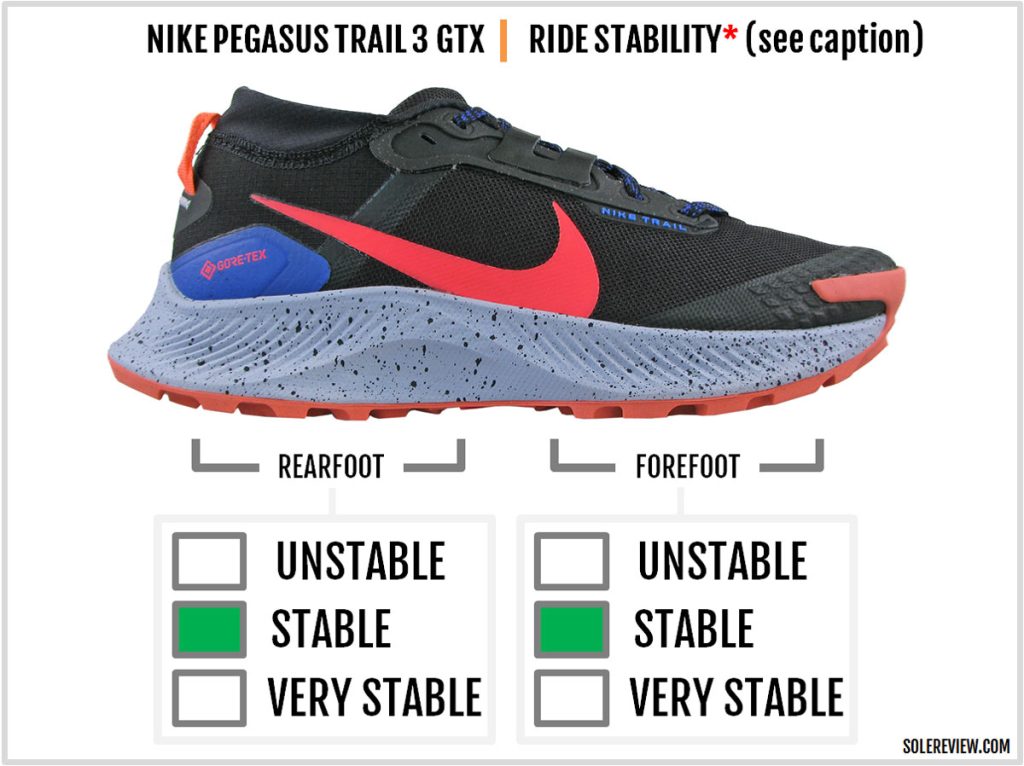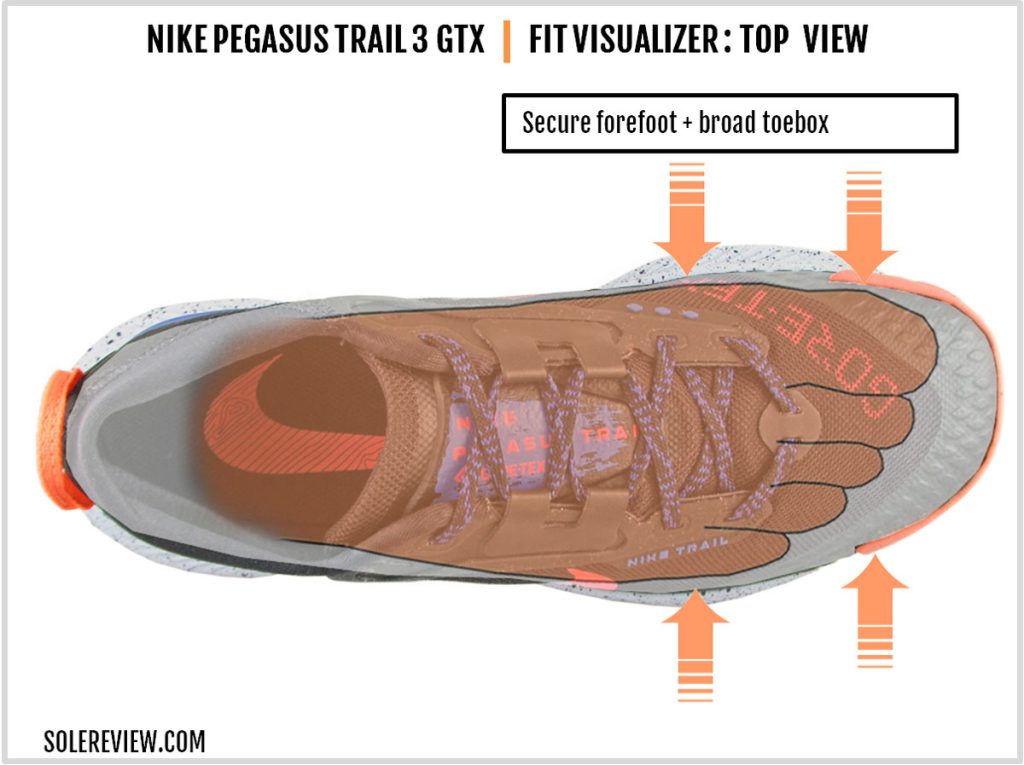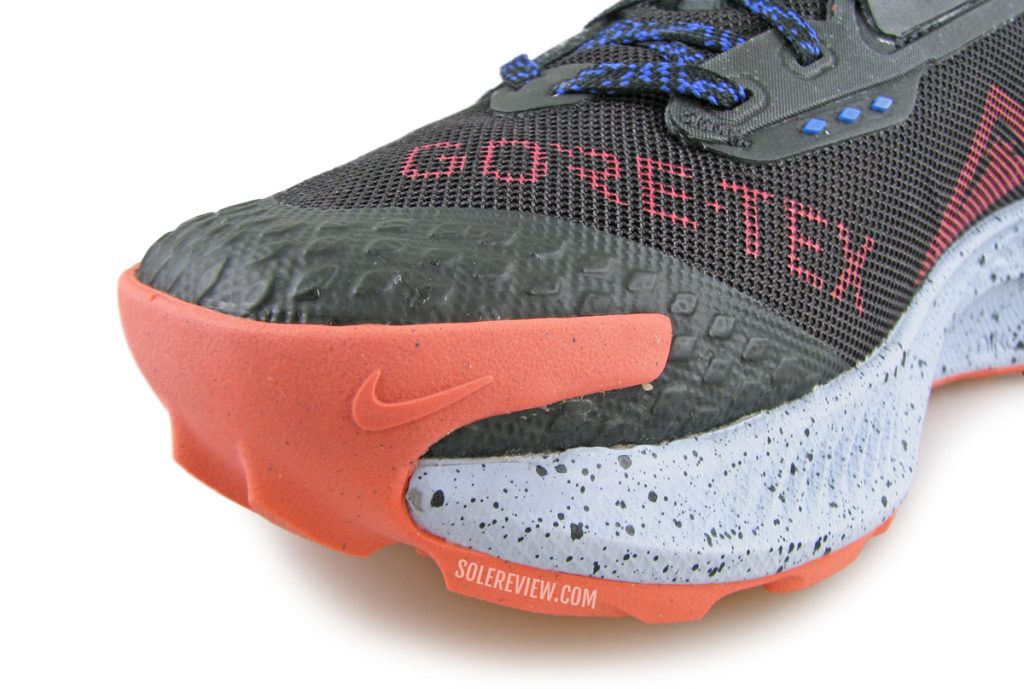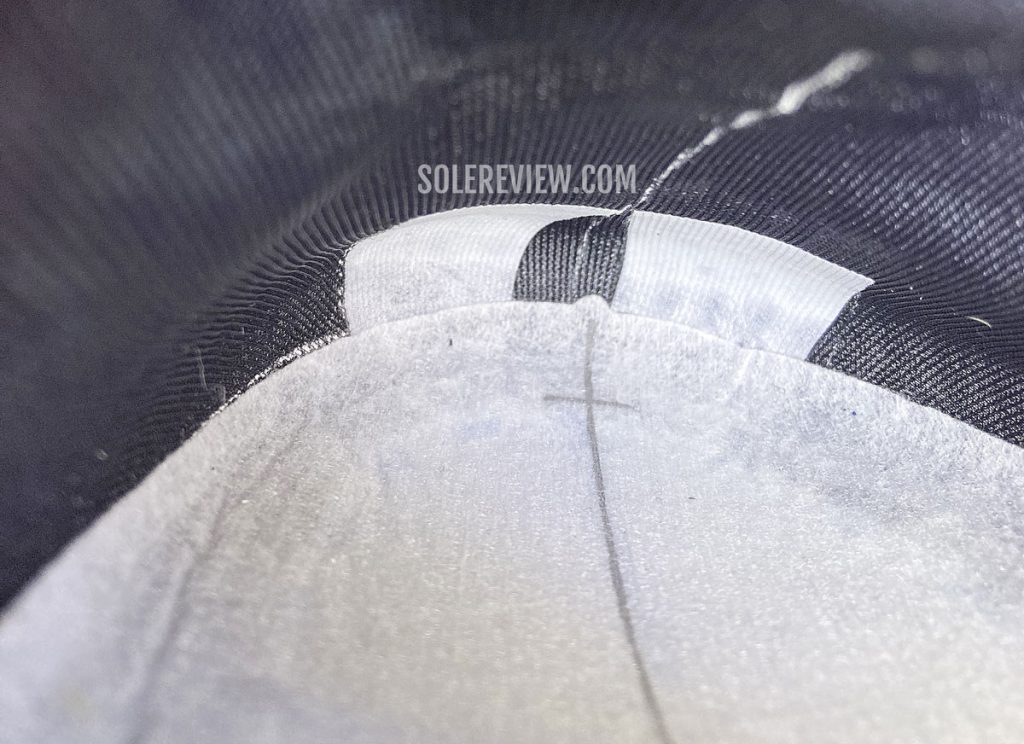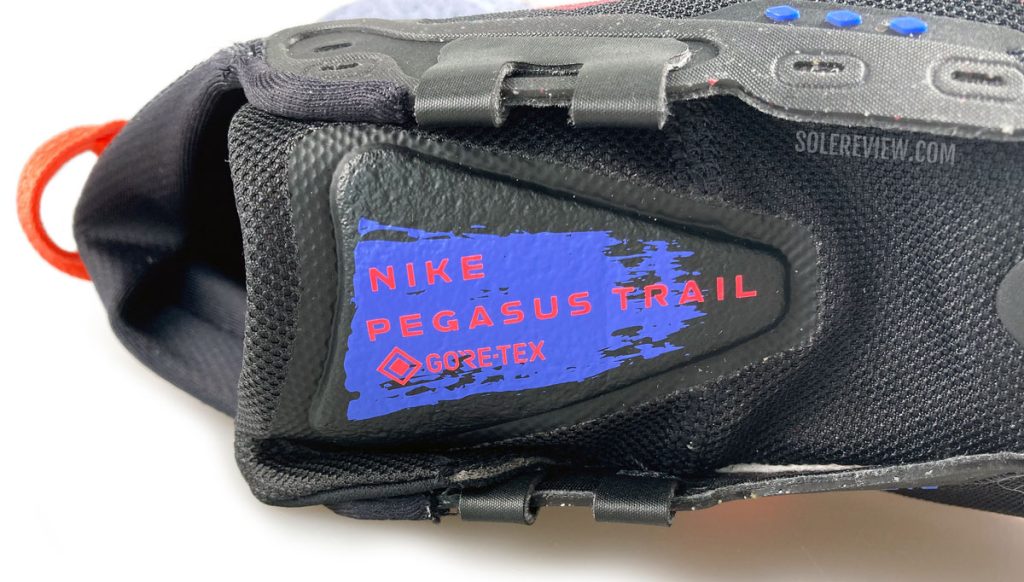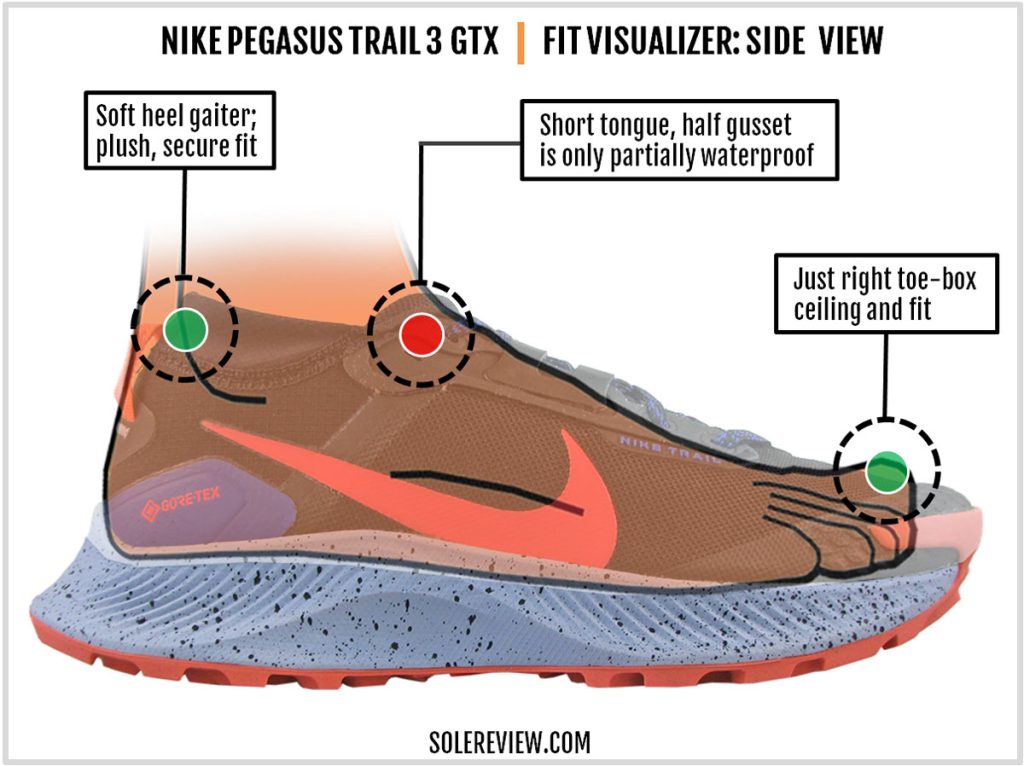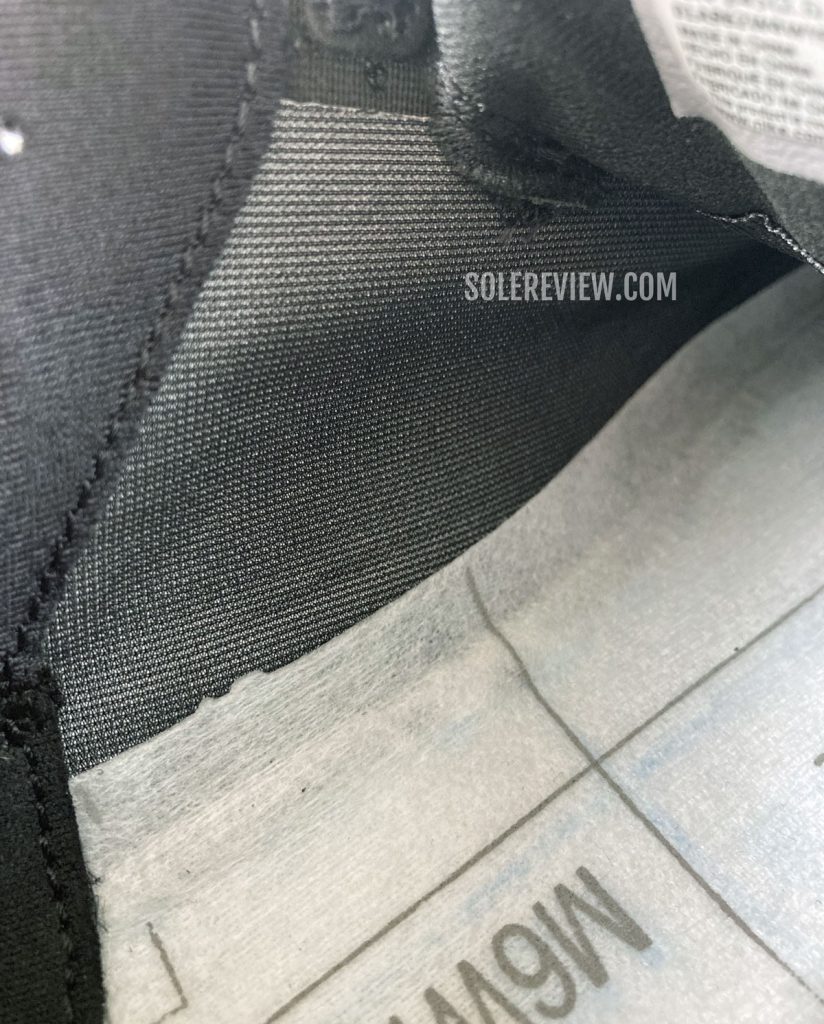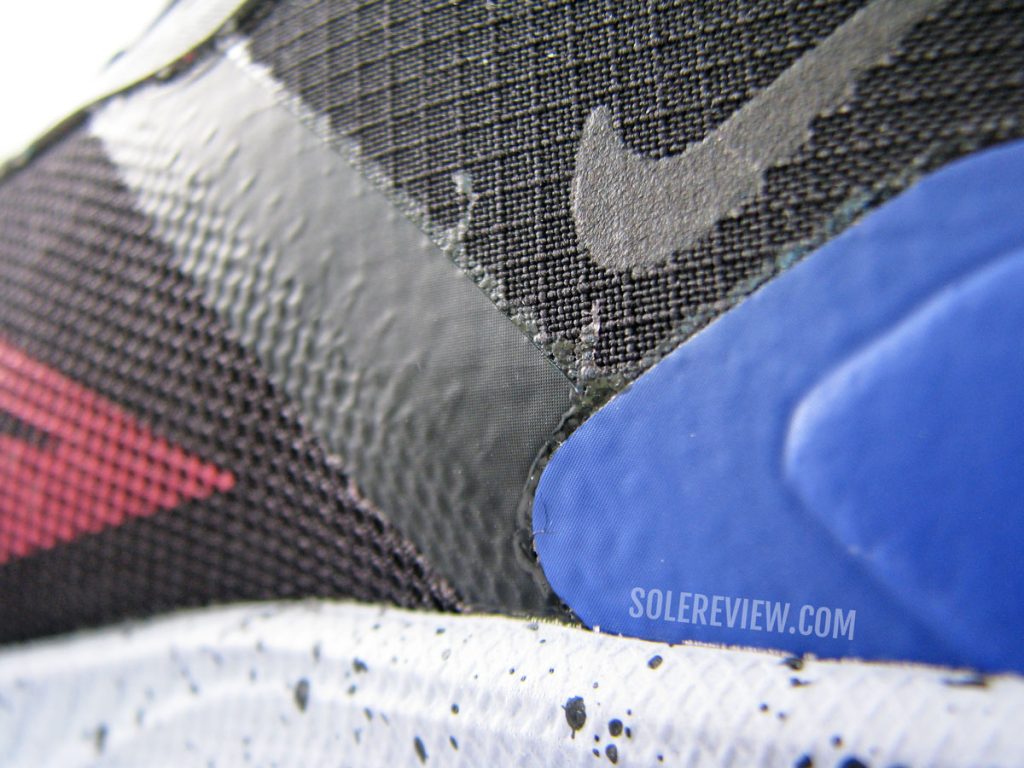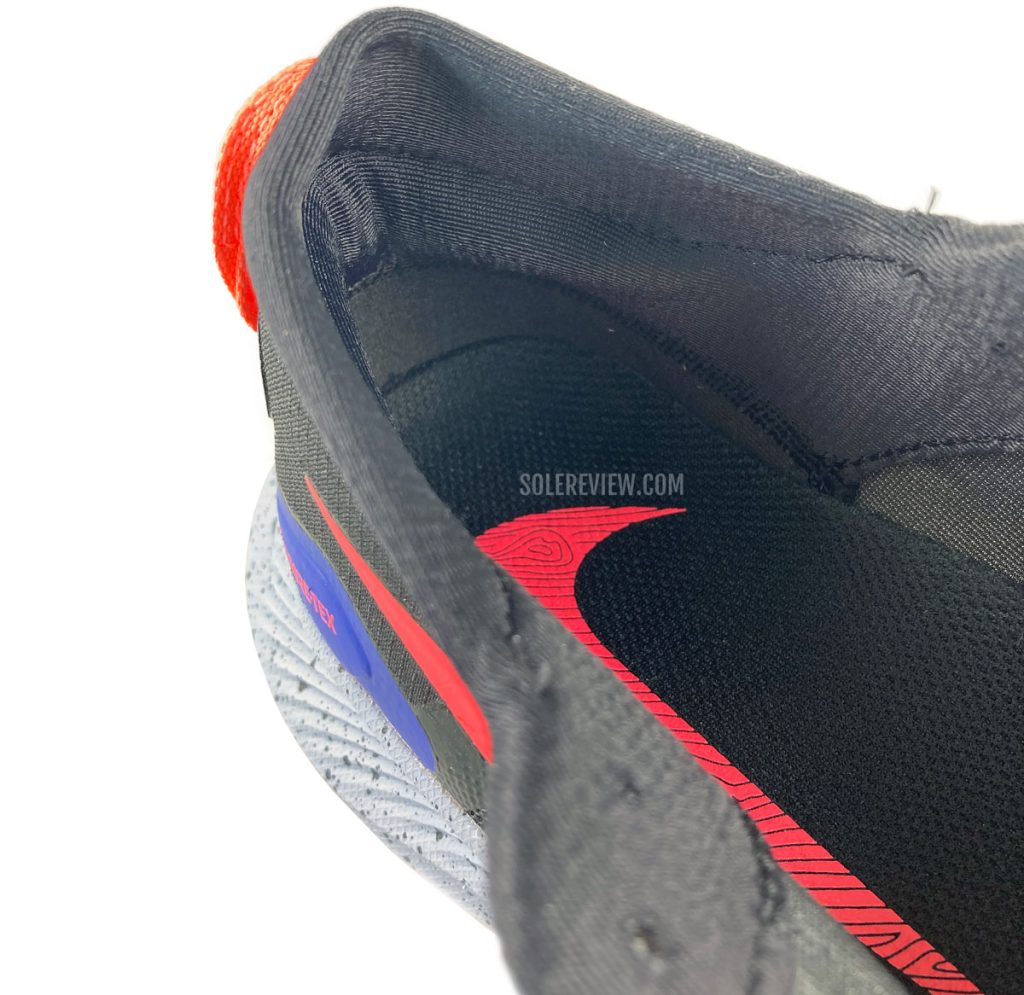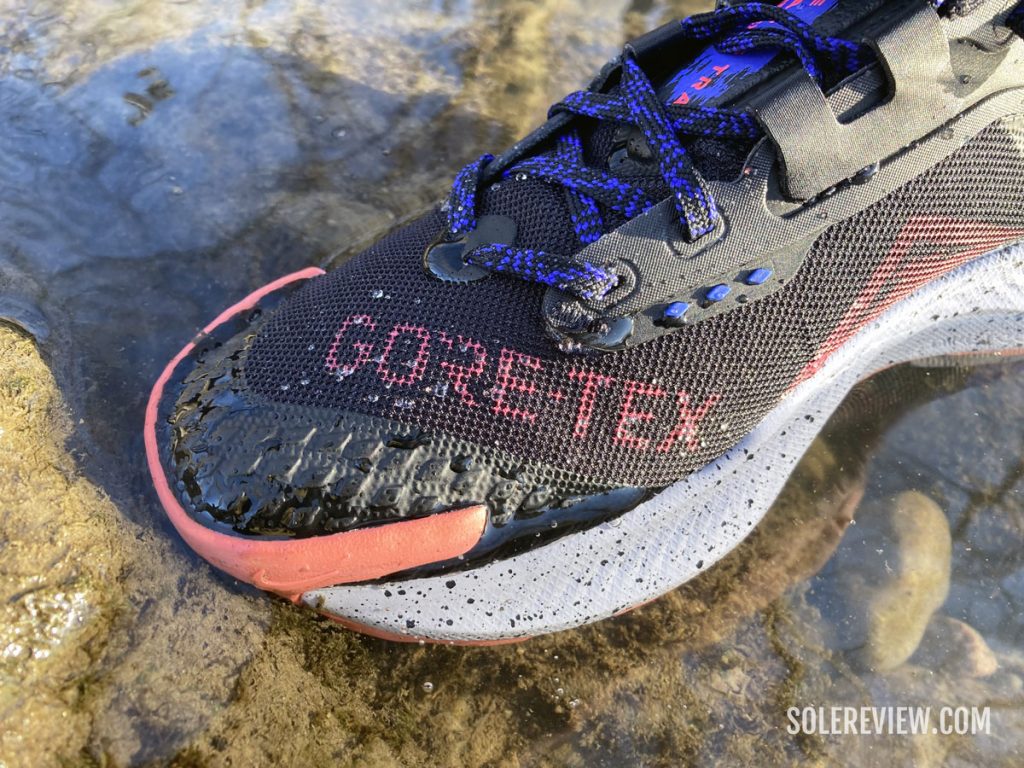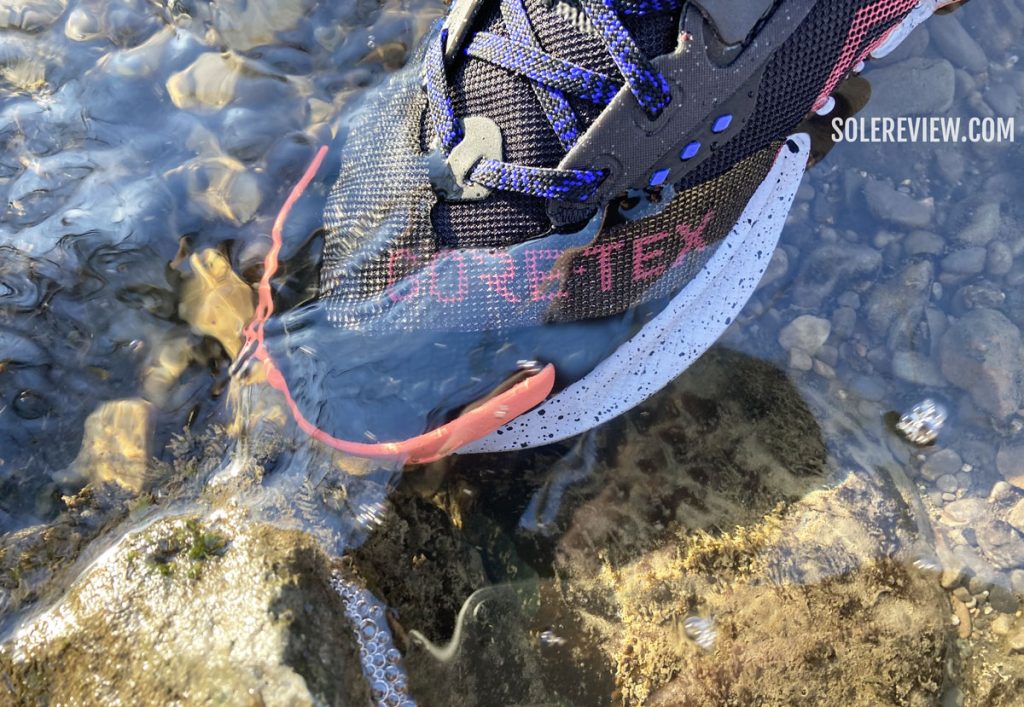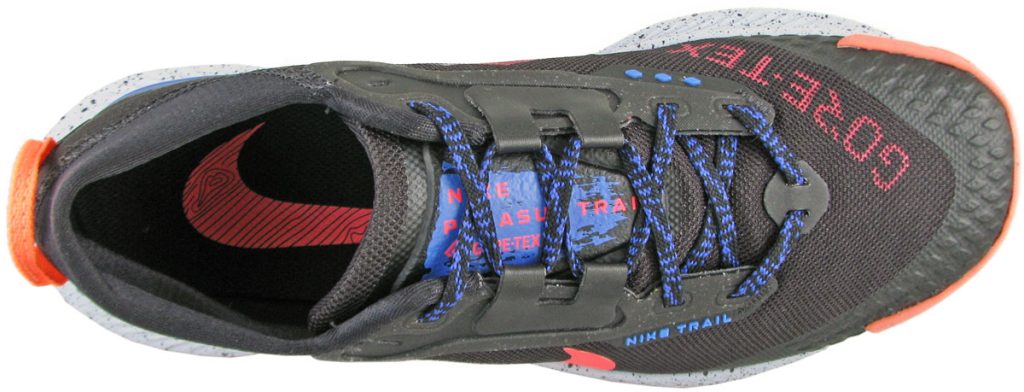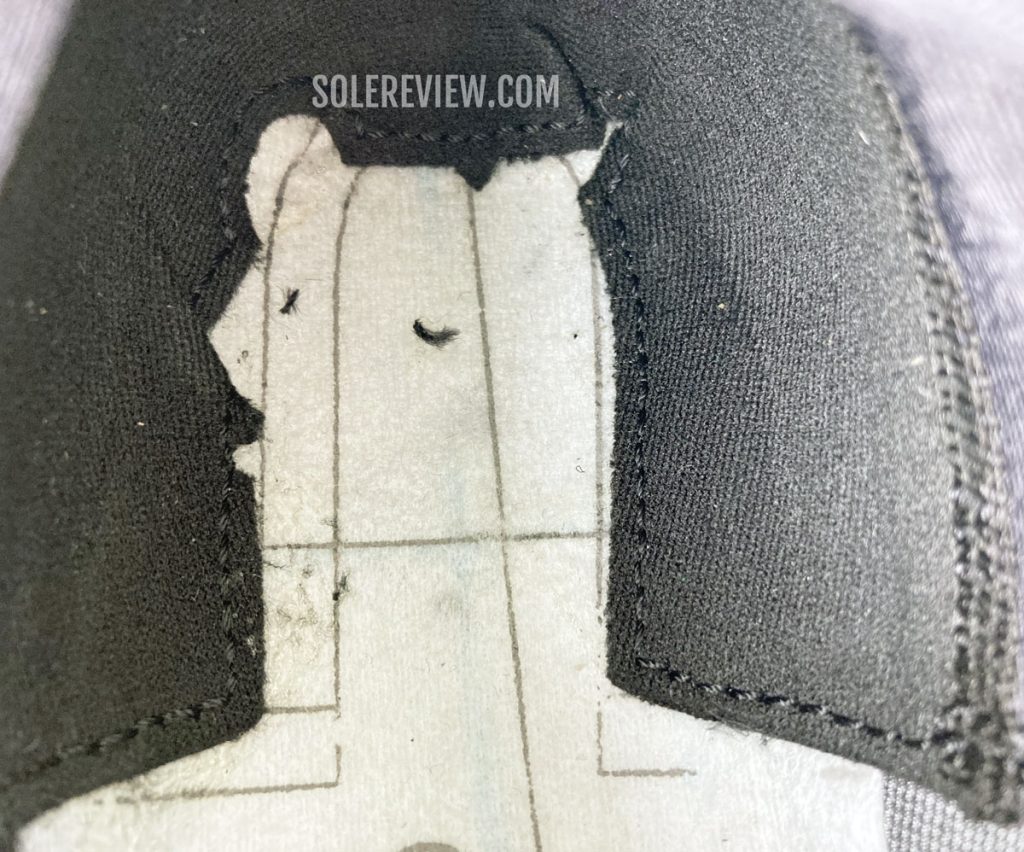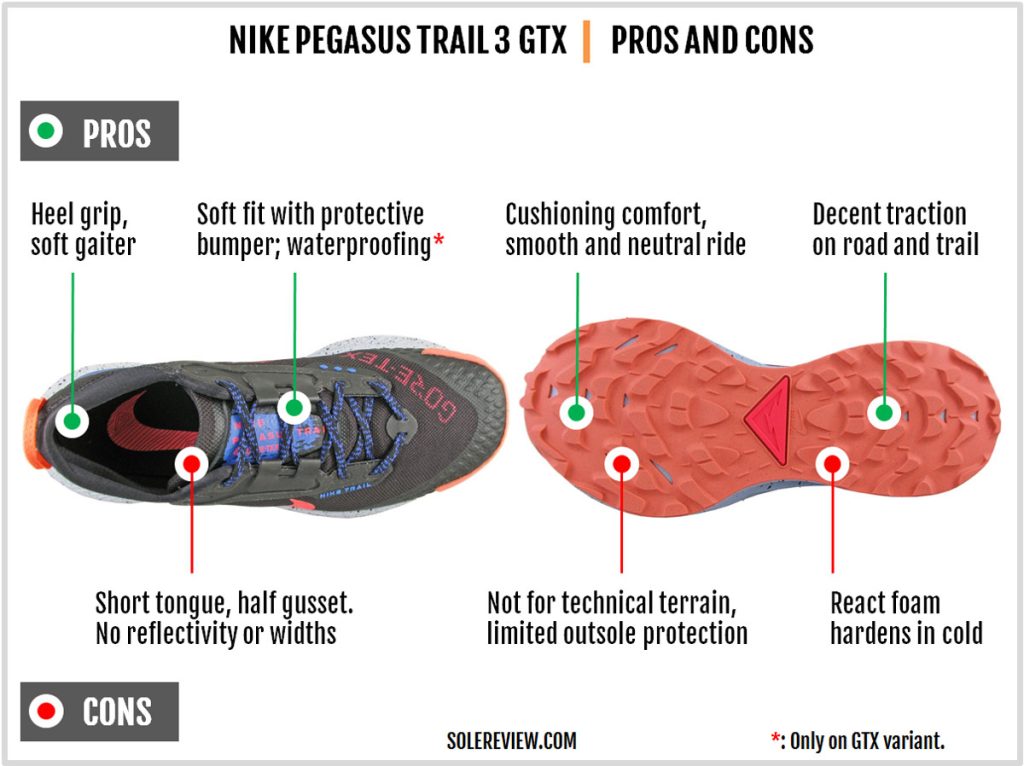The Nike Pegasus Trail 3 Gore-Tex was purchased at full retail price for our review. The amount is in Canadian Dollars.
INTRODUCTION
Three years ago, the Pegasus 36 Trail dropped out of nowhere. It was a rugged, off-road version of the standard Pegasus 36.
The Peg 36 Trail wasn’t a ‘true’ trail running shoe, though.
It was similar to what Asics did with its GT-2000 ‘trail’ variants. Which was, take the existing road shoe design and add an outdoors color scheme with a slightly modified outsole.
Just like the road Pegasus 36, the Trail edition used a split outsole design and deep groove. Even the upper was light on the protective detail.
The Pegasus Trail 2 was different. It lost the Zoom Air bag as well as the articulated outsole geometry. In their place were a softer React foam midsole and a single-piece outsole without a transition groove.
The upper was also reinforced to make it trail-worthy; the outsole wrapped over the toe-box to create a protective bumper. The forefoot also had high-density printing to prevent mesh tear. In the rear, a soft gaiter helped keep the debris out.
The Pegasus Trail 3 is built on the same foam and rubber chassis as the V2, so the ride hasn’t changed.
It’s a comfortable off-road running shoe that works best on non-technical trails; the outsole traction is decent for its lug geometry.
You know where we’re leading with this – the Pegasus Trail 3 isn’t a hardcore running shoe designed for technical terrain.
Its toned-down trail shoe character makes it an excellent trail-road hybrid with a high level of ride comfort.
It works best on flat sections or gentle gradients where the React midsole and rubber outsole can be utilized to their full potential. The soft midsole also lacks a rock plate.
It’s easy to see that the Pegasus Trail 3 prioritizes ride comfort over technical trail capabilities.
By being what it is, the Pegasus Trail 3 also adds a lot of value to Nike’s trail running shoe assortment.
For a higher level of ride comfort and protection, there’s the Zoom Wildhorse 7 with its thicker midsole and rock plate. For a firmer, yet protective and proprioception-friendly ride, the Nike Terra 7 is the shoe to get.
All three trail shoes are priced similarly, so it’s simply a matter of appropriate use case.
For this review, we chose the Pegasus Trail 3 Gore-Tex that’s $30 more expensive than the standard model.
Besides the waterproofing, the GTX variant also gets the soft gaiter attached to the heel collar. On the flip side, there’s no gaiter attachment point on the forefoot.
It’s interesting to note that while the Pegasus Trail 2 had a gaiter in both the standard and GTX versions, here, only the GTX model has it – so it makes sense to buy this over the other despite the price premium.
Just so that you know, we’re reviewing the women’s Pegasus Trail 3, which is the same as the men’s model – except for the narrow ‘B’ width.
THE RIDE EXPERIENCE
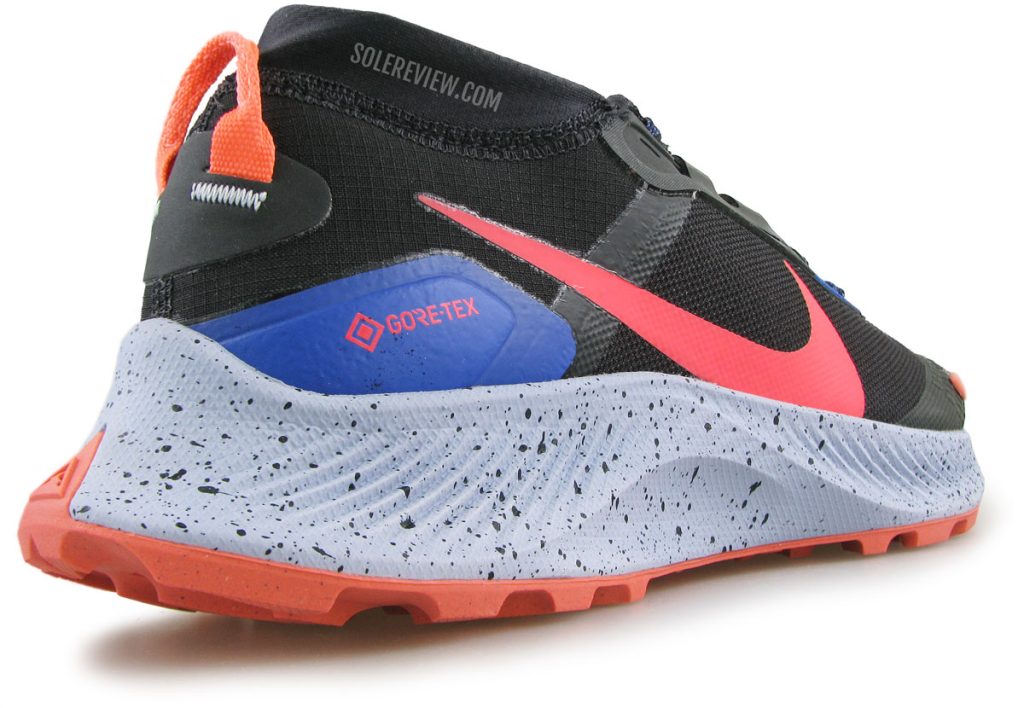
The midsole design is fairly straightforward. It’s made of Nike React foam without additional cushioning inserts.
The Pegasus Trail 3’s ride character is very easy to read.
That’s not surprising given its simple build – the midsole is made just of Nike React foam without an internal cushioning system or rock plate.
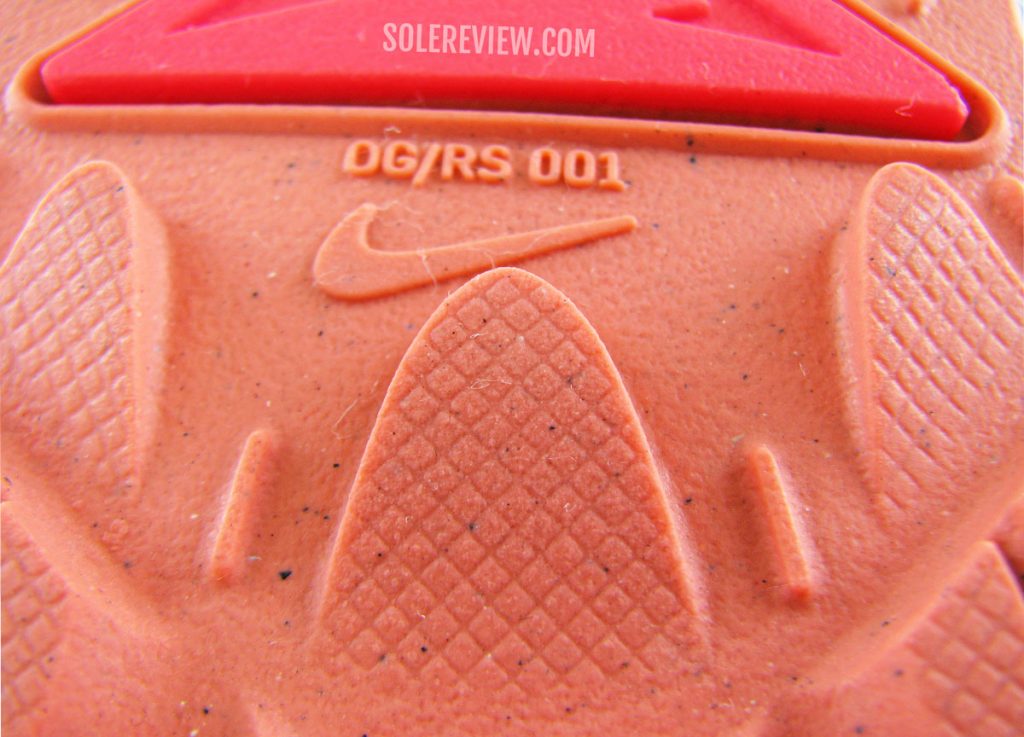
The outsole has low lug clearance, and that’s good for running on flat surfaces. The traction is decent.
The said midsole is protected by a full-length rubber outsole with shallow lugs.
The rubber compound is Nike’s RS 001 that offers satisfactory traction over most surfaces – unless we’re talking about ice or wet rocks where most outsoles struggle to grip.
Ortholite insoles had been missing on Nike running shoes for a while, so we’re happy to see them return.
Inside the Pegasus Trail 3 is a removable footbed with a blown foam base; this soft layer blends perfectly with the comfortable React midsole.
The Pegasus Trail 3’s midsole is made entirely of Nike React foam, so its ride quality depends on how warm or cold the temperatures are. Yes, that’s a thing that very few reviews call out. React foam is soft on hot days, and hardens in below-freezing temps.
In our review of the first Nike running shoe with React foam, we called out this material’s tendency to stiffen during the cold. Likewise, this midsole hardens considerably in temperatures below freezing.
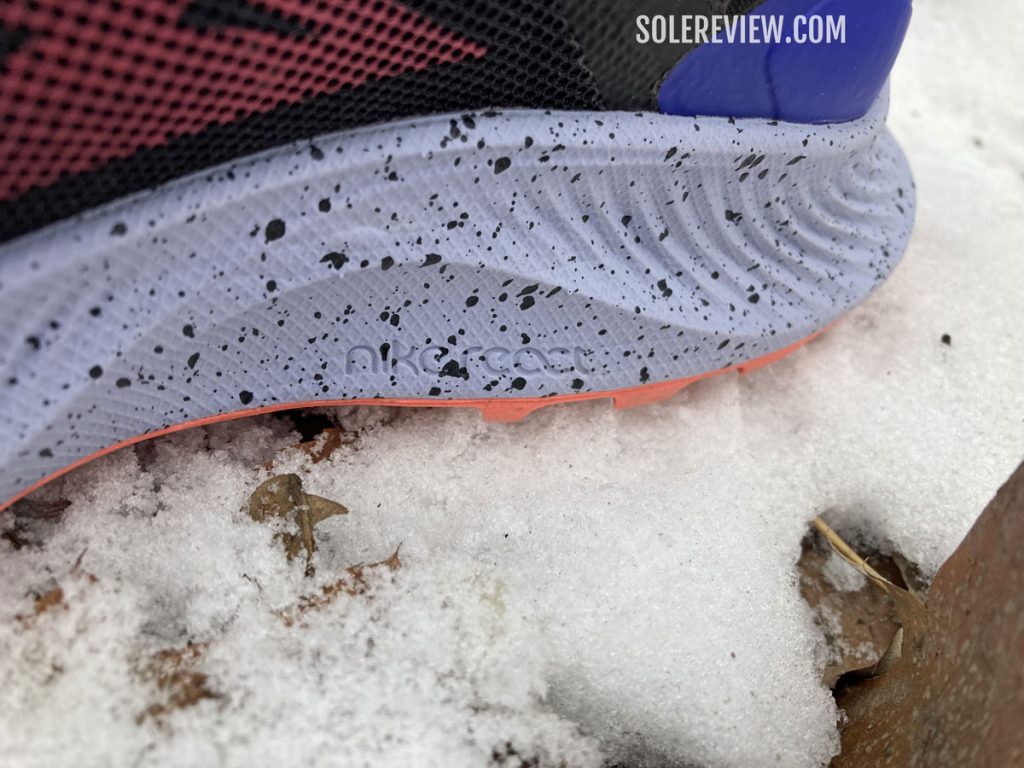
The React foam hardens in below-freezing temperatures. Though that’s a flaw, it had the unintended consequence of improving stability.
Our testing was conducted during winters with a wide temperature range consisting of mild (above 0° C/32° F) and below-freezing days. During the coldest day (-7° C/ -19° F), the Pegasus Trail 3 turned into a much stiffer shoe.
Looking back, the name ‘React’ was oddly prescient, as it ‘reacted’ to changing temperatures. Other new-age foams like Nike ZoomX and adidas Boost are unaffected by temperatures.
Therefore, many runners will form a different opinion about the Pegasus Trail 3 based on where – and when – they run.
At temperatures (above 5° C/41° F) and warmer, the React midsole has a soft and compliant ride with a high level of comfort. Conversely, a stiffer midsole has a lower level of ride comfort but becomes more stable.
The firmer ride during winter runs is actually a good thing. And no, this is not sarcasm.
Not only does the stiffer midsole become more protective and stable over the trail, but its transition quality also becomes better. Runners will find the Pegasus Trail 3 more amenable to speed runs during the winters than warmer weather.
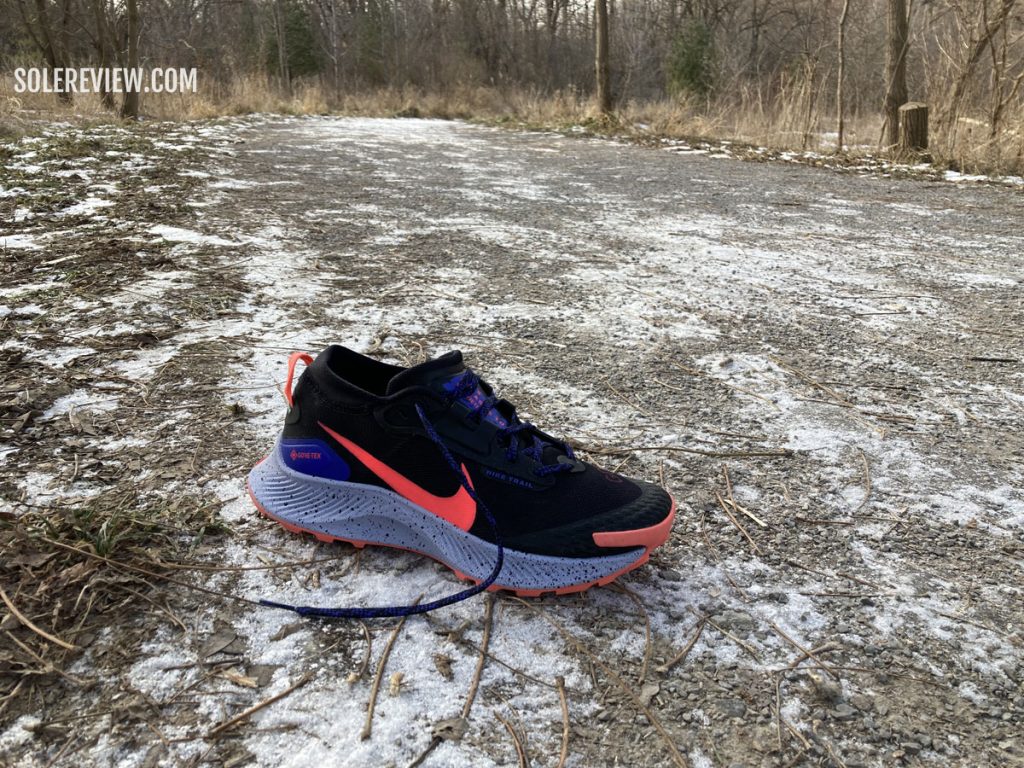
The Pegasus Trail 3 is nearly perfect for running on gravel or packed soil with flat or minimal grade.
During warmer days, the Pegasus Trail 3 is an excellent cruising shoe.
Its cushy React midsole and mild outsole lug are perfect for flat trails and gentle gradients; it’s only on these surfaces where the ride comfort comes into its own.
The foam midsole has a nice bounce to it. Unlike the Pegasus 36 Trail, there’s no Zoom Air bag inside. That said, the React foam has a pleasing pep in its cushioning that makes long-distance runs comfortable.
It’s not just about the foam density. The sidewalls have a generous inwards scoop that helps with the cushioning process, and is supported by a wide outsole base.
Readers will notice that the midsole has a balanced sidewall design with no bias – both the inner and outer sides are nearly identical. Like its road version, the Pegasus Trail 3 has a very neutral ride character.
The shallow lugs have a flat texture, so the occasional road-hopping won’t wear them down as quickly as a trail outsole with pointy lugs. The rear outsole has a fair bit of (outwards) lip, and that provided much-needed contact area during downhill runs.
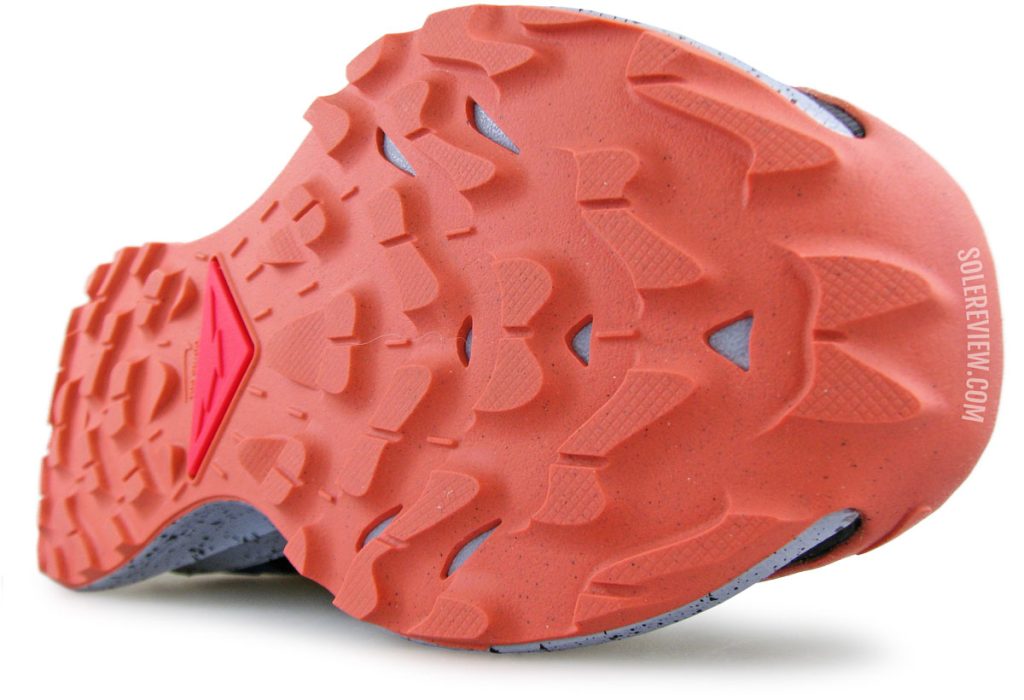
The soft midsole lacks a rock plate, so it’s not very protective. It’s best to keep off technical terrain.
The lack of a rock shield and aggressive lug design limits the Pegasus Trail 3’s versatility. On warmer days, the soft midsole and perforated outsole do not offer the protection that plate-equipped shoes do.
The Pegasus Trail 3 can be used on most gentle trails; just don’t expect the performance capabilities of a fully-kitted trail running shoe.
Else, it’s a very comfortable road-trail hybrid with a generous amount of ride and fit comfort.
THE UPPER DESIGN AND FIT
As the Pegasus Trail 3 carries over the midsole and outsole from the Trail 2, it inherits a similar toe-box aesthetic.
The protective toe-bumper is a clever design that uses the outsole as an extension of the upper. While we’re sure this is a nightmare (look at all the glue marks) from a manufacturing perspective, the functional rubber bumper is also a unique visual marker.
This also gives the toe-box a broad profile with plenty of toe splay room. The forefoot is snug over the small toe, and while the last has the final word in the matters of upper fit, the lacing design also plays a significant role.
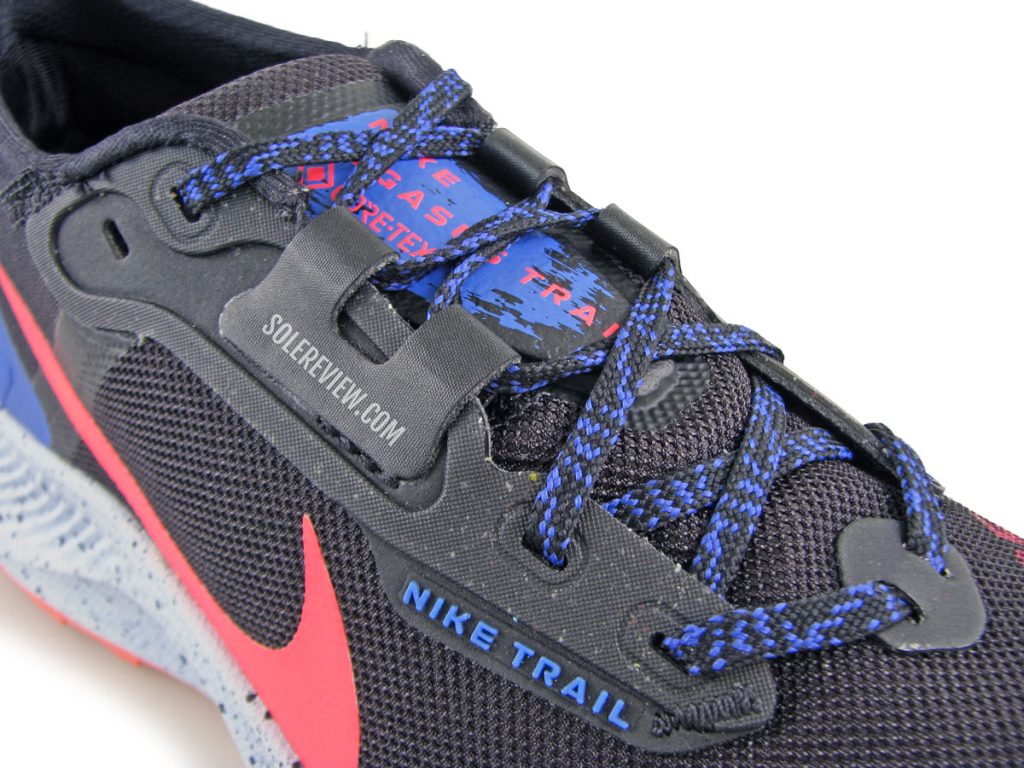
The first loop adds an element of fit security. The midfoot loops also make it easier to cinch the laces.
The first row of lacing also threads through a loop over the forefoot before connecting to the eyelets. This helps secure the forefoot and also prevents the mesh from gathering.
Though the tongue keeps the foam padding to a minimum, there’s a thick molded pad on the flap that absorbs the lacing pressure.
We’d like to point out that the Pegasus Trail 3’s tongue design replaces the interlocked flap of the V2. The flap is softer, but shorter than the Pegasus Trail 2 – so things get crowded when the last row of lacing is used.
If you want a slightly relaxed fit, just skip lacing through the forefoot loop. We say this because the Pegasus Trail 3 only sells in a single width – which is ‘B’ for women’s, and a ‘D’ for men’s.
Both the GTX and non-waterproof variants use a soft mesh. Even the Gore-Tex upper is surprisingly soft and pliable and doesn’t create a paucity of space. Both the models fit true-to-size.
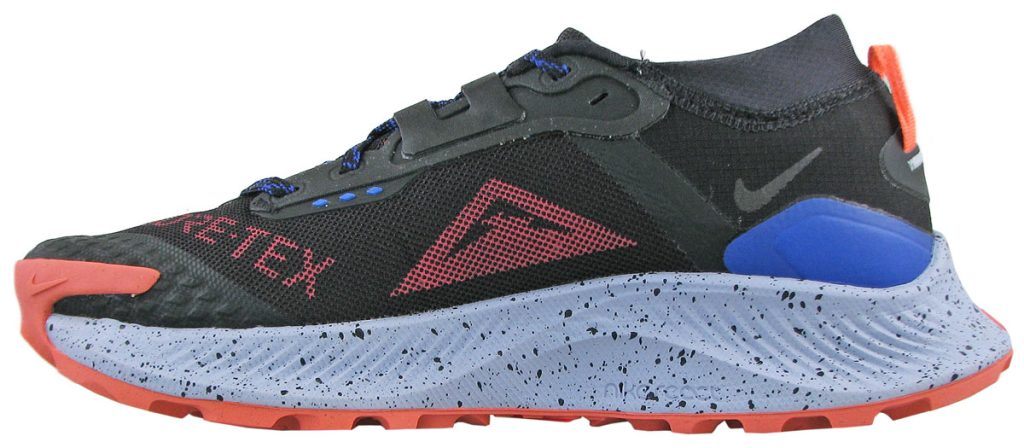
Except for the toe bumper and some layering in the rear, the upper isn’t covered with protective details.
Just like the midsole and outsole, the upper isn’t overly structured. Except for the protective toe-bumper and reinforced lacing eyestay, the mesh upper is left relatively uncovered. The large Swoosh logo on the outer is fused Urethane, but the arch side is all mesh.
It’s easy to slip into the shoe. Though the tongue is attached to the upper, it also has a working flap for ease of entry.
The heel has a few things going on, like the large pull tab and molded overlays. Since there’s a full-sized stiff counter inside the heel, the molded layers are cosmetic.
There’s no reflectivity on the Pegasus Trail 3 – not even a high-visibility heel strap like what the Brooks Cascadia 16 has. We guess Nike wants everyone to buy the Pegasus 38 Shield instead – which, by the way, isn’t a trail shoe.
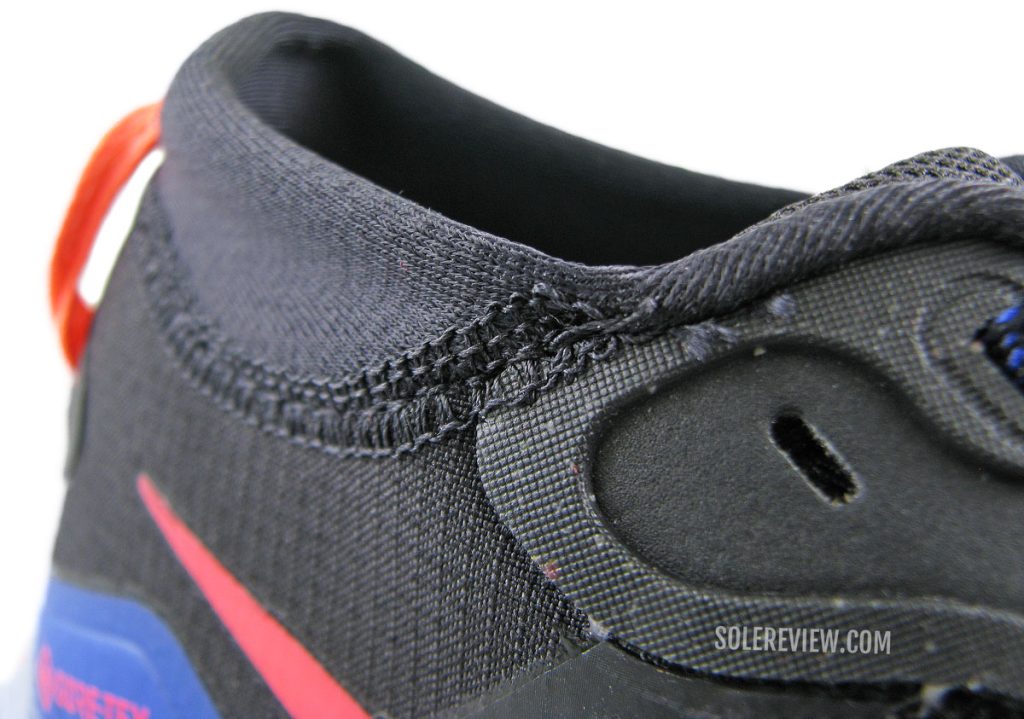
The Gore-Tex variant has the soft gaiter; the standard Pegasus Trail 3 does not. However, it’s worth noting that the Pegasus Trail 2 did not discriminate.
The heel fits better on the waterproof model, and should we say, feels better. That’s because it uses a gaiter, whereas the non-waterproof Pegasus Trail 3 does not. There are foam pods inside the collar that do their job and create a secure heel grip.
Just know that the gaiter is not lined with Gore-Tex, so it’s designed to keep just the debris out – not water.
Otherwise, the rest of the upper has reliable waterproofing. Running in the rains will delay the entry of water when compared to non-waterproof shoes, and the occasional splash from crossing a shallow stream won’t ruin your run.
Except for the toe area, the upper is not all that protective – the medial side is all mesh, whereas the Urethane swoosh provides some protection. The stiff heel counter is supported with a fused layer and ripstop mesh. The large and functional pull loop is a useful feature to have.
As we said, the Pegasus Trail 3 is a shoe meant for mild trail run – nothing more.
PROS AND CONS
The Pegasus Trail 3 is what we call an ‘easy reach’ shoe. The outsole geometry is mild enough for road runs as well as outdoor terrains that doesn’t involve high-difficulty gradients.
There’s ample React inside the midsole to make it comfortable enough for long miles on non-technical trails. The upper has a smooth and secure fit, and the soft gaiter on the Gore-Tex version is useful. The water-proofing on the GTX version is effective at keeping the water out.
We also like the unique toe-bumper on the upper, as well as the broad toe-box profile.
It’s worth bearing in mind that the Pegasus Trail 3 is not your versatile, do-everything trail shoe. It lacks a rock plate as well as deep outsole lugs; its cushy ride isn’t very protective either. And if you wanted to attach a gaiter, the loop or D-ring is missing on the forefoot.
So while this shoe has a ‘trail’ suffix, it has limited versatility. Given its mild nature, we’d keep the Pegasus away from technical trails.
Nike’s React foam hardens in the cold, so its cushioning delivery is inconsistent across seasons.
SHOES SIMILAR TO THE NIKE PEGASUS TRAIL 3
Here, we’re comparing the Pegasus Trail 3 with outdoor shoes with a lower technical level than the Saucony Peregrine 11, Brooks Cascadia 16 (our review is here) and even Nike’s Terra Kiger 7.
Comparable products would be trail shoes with low-profile lugs and a comfortable midsole and upper.
When we apply that selection criterion, we are presented with choices like the Asics Cumulus 23 AWL and New Balance Fresh Foam Hierro 6 – along with many others.
Out of all the alternatives, the Asics Cumulus AWL, Fuji Lite 2, and Hierro are the closest match.
The Cumulus AWL (All Winter Long) is a weather-resistant variant of the road Cumulus; the upper is water-repellent and protective. There are extras like the toggle lacing and protective toe-bumper over a ripstop mesh upper.
The Asics Fuji Lite 2 isn’t weatherproof, but it shares similar functional traits with the Pegasus Trail 3 – like the comfortable Flytefoam midsole, mildly protective upper, and the Asicsgrip outsole.
Other alternatives would be trail running shoes like the Altra Timp 3, Brooks Catamount, and Salomon Ultraglide. All these models share common traits like a cushioned and compliant midsole without a rock plate, along with comfortable uppers without excessive layering protection.
Do you own this shoe? Improve this review by sharing your insights – submit a review here.

